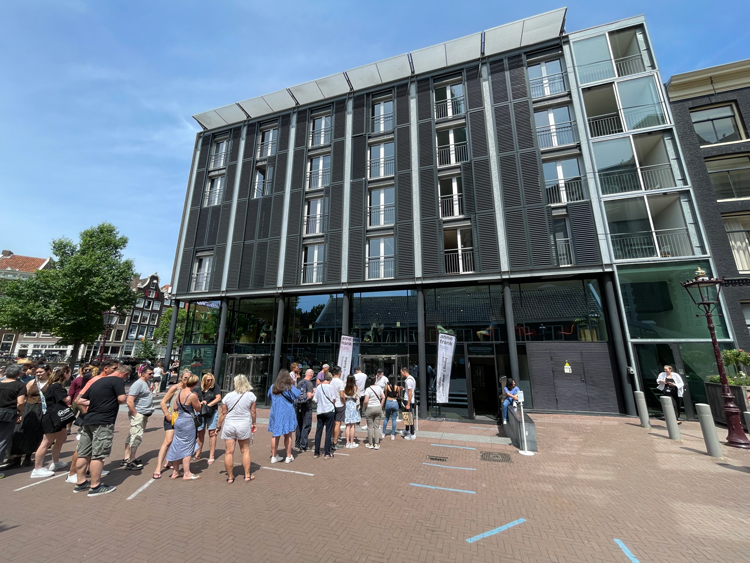The Anne Frank House attracts a large number of visitors in Amsterdam as one of its most popular attractions during a city trip. The museum serves as a memorial to Anne Frank and her family, who went into hiding in Amsterdam. On her 13th birthday, Anne received a diary in which she frequently wrote. She documented their entire period in hiding within its pages. Unfortunately, the Frank family was eventually discovered and sent to a concentration camp. Following the end of World War II, Anne’s father became the sole survivor. He took it upon himself to publish Anne’s diary and transform their secret hiding place into a museum.
The story of Anne Frank
Anne was born in Frankfurt in 1929. In this period things went very badly with Germany. Hitler got bigger and bigger with his party. Many people joined. He said it was the Jews’ fault that things went so badly with Germany. For this reason Anne and her family moved to Amsterdam. Everyone had found their niche here.
In 1939 the second world war started. Nazi Germany invaded Poland and one year later the Netherlands as well. Soon the Netherlands surrendered and more and more things were forbidden for Jews. For example, Jewish people were not allowed to have their own business, so Anne lost her father’s business. Jewish children also had to attend separate schools. Later it became worse and worse. All Jewish people had to wear a yellow star, so it was easy to see who was Jewish. Anne was 10 years old at the time.
Hiding in The Secret Annex
At one point every Jewish person had to report to the Nazi. They were told that they had to go to Germany to work. Anne’s sister also received this call in 1942. The Frank family therefore decided to go into hiding. The family could not believe that you went there to work. They made a hiding place in Anne’s father’s old business in the secret annex. Anne’s father’s old colleagues help him. A few days after they went into hiding, another family joined them. They were not allowed to make a sound upstairs. When she turned 13 she got a diary. This way she could write down everything they went through and what she thought.
From England Radio Oranje was called in to keep all the documents and diaries of the war. Anne got an idea. She decided to write her diary again, but as an ongoing story. And she called it The Secret Annex. She was never able to finish it, because in 1944 the police discovered the two families. The people who helped the family were also arrested. Two other helpers were able to get the diary quickly.
And then it happened….
Authorities herded Anne and her family, along with many others, into cramped wagons, subjecting them to dreadful conditions and a severe scarcity of food. They transported them to the Auschwitz-Birkenau extermination camp. Upon arrival, after enduring three arduous days of travel, the authorities conducted a sorting process to determine the fate of each individual. They swiftly directed those deemed unable to work to the gas chambers, while they assigned Anne, her sister, and her mother to the women’s camp, and directed her father to the men’s camp.
In the same year, 1944, Anne and her sister were again transported to Bergen Belsen concentration camp. In this camp it was dirty, wet, no food and a lot of contagious diseases. Anne and her sister both contracted typhus, so they did not survive.
The Russians liberated Anne’s father from Auschwitz, making him the sole survivor of the entire Frank family. The helpers returned Anne’s diary to him belatedly, and he took it upon himself to ensure that her story would be heard. They produced a film, and in 1969, they transformed The Anne Frank House into a museum. Anne’s father passed away in 1980.
The Anne Frank House
History
Nestled in the heart of Amsterdam, the Anne Frank House stands as a poignant symbol of resilience, hope, and the enduring power of storytelling. This historic site, once a hiding place for Anne Frank and her family during the dark days of World War II, has evolved into an iconic museum that captivates visitors from around the world. In this article, we delve into the fascinating story of the Anne Frank House, its restoration, and the profound impact it continues to have on individuals today.
Amid the turmoil of the Second World War, Anne Frank and her family sought refuge in the concealed rooms known as the Secret Annex. For two years, they lived in constant fear, documenting their experiences and hopes in Anne’s now-famous diary. The Anne Frank House preserves this tangible connection to the past, allowing visitors to step into the lives of those who endured unimaginable hardships during this dark period of history.
Following the war, the Anne Frank House faced the threat of decay and potential demolition. It was through the establishment of the Anne Frank Foundation in 1957 that a passionate group of individuals united to ensure the preservation of this significant historical site. Against all odds, they embarked on a restoration journey, meticulously reviving the space while respecting its original essence.
Visiting the Anne Frank House
The Anne Frank House goes beyond being just a museum; it actively fosters understanding, tolerance, and empathy among its visitors, functioning as a powerful educational institution. By offering exhibitions, educational programs, and outreach initiatives, the Anne Frank House provides a comprehensive exploration of Anne’s life, the Holocaust, and the invaluable universal lessons derived from her remarkable story. It serves as a catalyst for engaging discussions on human rights, discrimination, and the significance of embracing diversity.
Visiting the Anne Frank House is a deeply moving and personal experience for many. Countless individuals, from all walks of life, have been profoundly touched by the authenticity and emotional weight of the museum. We share stories of visitors who have felt the indescribable connection to Anne’s words, gaining a deeper understanding of the human spirit and the resilience of the human soul.
The museum is open daily from November to April, with visiting hours from 9 a.m. to 7 p.m., and on Saturdays from 9 a.m. to 10 p.m. From April to November, the museum extends its hours, remaining open daily from 9 a.m. to 10 p.m.From April to November the museum is daily op from 9.00 to 22.00.
If you have difficulty walking, visiting the museum can be challenging due to the need to climb many steep stairs. Anne Frank House is located at Prinsengracht 362, but the museum entrance is at Westermarkt 20.
Entrance to the museum can be arranged here!
Anne Frank City Tour in Amsterdam
The Anne Frank City Tour in Amsterdam offers a unique and informative experience for visitors interested in learning about Anne Frank’s life, the Jewish quarter, and the impact of the Second World War. Led by knowledgeable guides, this walking tour takes participants on a journey through Amsterdam’s historic streets, providing insights into the city’s rich history and the events that shaped Anne Frank’s life.
During the tour, participants will have the opportunity to visit significant landmarks and important historical sites connected to Anne Frank and the wartime period. These include the Westerkerk, the church where Anne Frank could hear the bells from her hiding place, and the Jewish Historical Museum, which offers a deeper understanding of Jewish heritage and the community’s experience during the war.
The tour also highlights lesser-known locations that played a role in Anne Frank’s life, such as the Anne Frank School, where she attended classes, and the house where her friend Hannah Goslar lived. By exploring these hidden gems, participants gain a more comprehensive understanding of Anne Frank’s world and the challenges she faced during her time in hiding.
Important information
The Anne Frank City Tour is conducted in smaller groups, allowing for a more intimate and personalized experience. The guides share captivating stories, personal anecdotes, and historical facts, bringing the past to life and deepening visitors’ connection to Anne Frank’s story.
It’s important to note that the tour does not include a ticket for The Anne Frank House, as it focuses on the broader historical context of Anne Frank’s life in Amsterdam. However, participants have the option to purchase tickets separately and visit the Anne Frank House at their convenience.
Booking the Anne Frank City Tour online is a convenient and straightforward process. After completing the booking, participants receive a ticket that can be downloaded to their mobile devices or printed out. This ticket serves as proof of reservation and ensures a smooth check-in process upon arrival for the tour.
Whether you’re a history enthusiast, a fan of Anne Frank’s diary, or simply interested in gaining a deeper understanding of Amsterdam’s wartime history, the Anne Frank City Tour offers a thought-provoking and enlightening experience that will leave a lasting impact. Embark on this captivating journey and discover the significant role that Amsterdam played in Anne Frank’s life and legacy.






